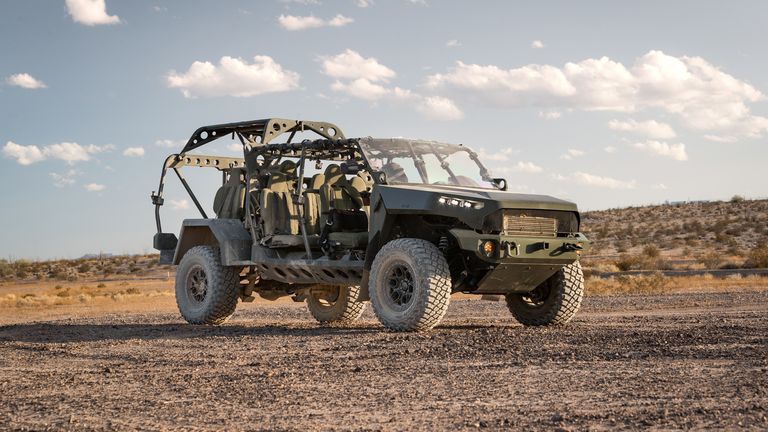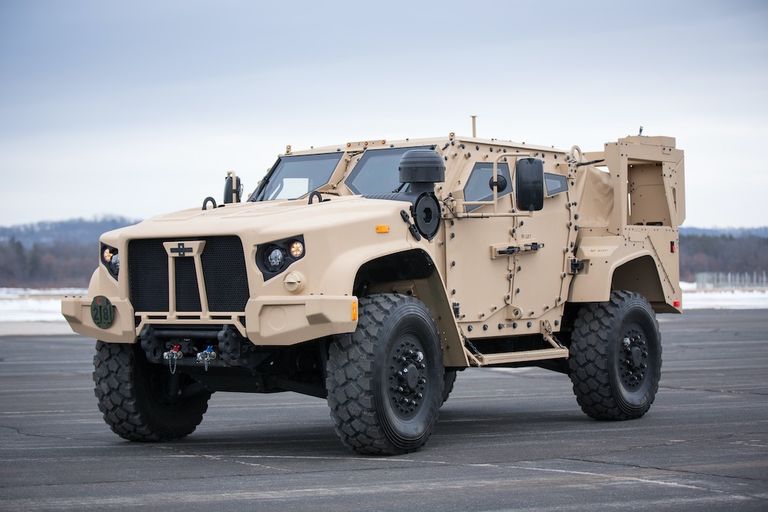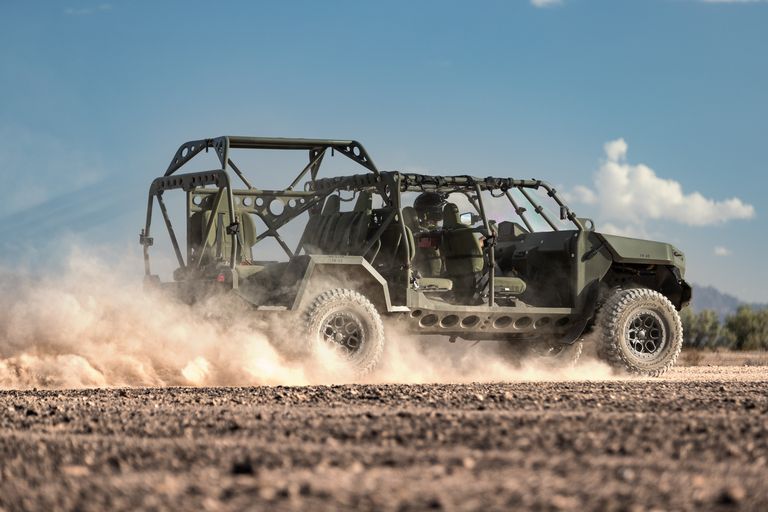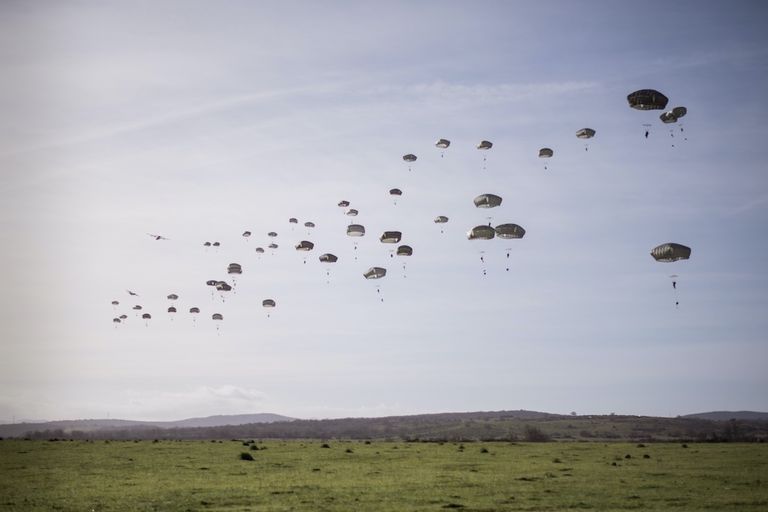Post by Admin on Jul 7, 2020 9:53:47 GMT
The Army's New Infantry Squad Vehicle...Is a Chevy?
There’s a pickup truck underneath all of that war paint.
BY KYLE MIZOKAMI

The U.S. Army has selected a new vehicle to speed troops across the battlefield. The new Infantry Squad Vehicle is fast, can be carried by helicopter, and has room for heavily armored soldiers. Unlike most military vehicles, it actually has a civilian background: the new vehicle is based on the Chevy Colorado mid-size pickup truck.
According to Defense News, the Army has awarded GM Defense $214 million to produce 649 Infantry Squad Vehicles (ISVs) for delivery by 2028. The Army hopes to eventually purchase up to 2,065. The ISV is meant for light infantry forces, particularly the 82nd Airborne Division, 10th Mountain Division, and 101st Air Assault Division. Other units that could end up operating the ISV include the U.S. Army Rangers and Special Forces.

U.S. Army JLTV.
The U.S. Army is buying up to 49,000 of the new Joint Light Tactical Vehicle (JLTV) to partially replace the iconic Humvee. Unfortunately, the new vehicle is anything but light, weighing a whopping 14,000 pounds, and at 8.5 feet has a tall battlefield profile. The JLTV is designed for situations where armored protection is needed at the expense of speed and mobility.
TEST DRIVE
We Drive the JLTV, the Humvee's Successor
The Infantry Squad Vehicle, on the other hand, fulfills a reverse requirement for a vehicle that prioritizes speed and mobility at the expense of armored protection. The result is a light, fast infantry carrier that can carry nine soldiers and their equipment cross-country. The ISV is based on the Chevy Colorado ZR2 pickup truck and has a curbside weight of just 5,000 pounds.
This content is imported from YouTube. You may be able to find the same content in another format, or you may be able to find more information, at their web site.
The ISV lacks a lot that comes standard on a civilian Colorado, starting with doors. It also lacks a roof, substituting a roll cage made of 4130 chromoly tubing. It has a single windshield and no windows. It even lacks a grill, leaving the radiator fully visible. The ISV is built light for air mobility—it can fit inside a CH-47 Chinook transport helicopter or slung under a UH-60 Blackhawk—and needs to carry up to nine soldiers and their gear. The ISV can 3,000 pounds, or about nine 200-pound soldiers and 100 pounds of individual gear each, plus 300 additional pounds of squad equipment (food, ammunition, medical supplies, shelter, Nintendo Switches).

The ISV is powered by a 2.8 liter Duramax diesel engine, providing 186 horsepower and 369 foot pounds of torque. It features a six-speed automatic transmission. The ISV is optimized for off-road performance, including an electronic locking differential, Chevy’s Desert Racing suspension, and Jounce shocks. It has 13.6 inches of ground clearance and a 46 degree approach angle, allowing it to handle tough obstacles in its path. Unlike the JLTV, the ISV has little to no armor. The most obvious armor is the skid plate protecting the transmission.

Paratroopers such as these from the 173rd Airborne Brigade could use ISVs to drop beyond enemy air defenses and then ride to combat.
Paratroopers and other shock troops will parachute or fly alongside their ISVs and then ride them to their objective. The ability to ride instead of walk allows the airborne force to drop farther from their objectives, making an airborne assault more difficult to defend against. In these situations, speed and mobility is arguably more important than protection. The ISV also offers a quieter, lower profile vehicle that can sneak across the battlefield if necessary.
But a fast, unarmored battlefield vehicle is a risk—the ISV offers virtually no protection against ambushes, improvised explosive devices, and artillery. Even rain is a problem for a vehicle without a roof. But in a battle, mobile forces often have a decisive advantage.
There’s a pickup truck underneath all of that war paint.
BY KYLE MIZOKAMI

The U.S. Army is buying the first of what will eventually be a fleet of more than 2,000 Infantry Squad Vehicles (ISVs).
The ISV is based on the Chevy Colorado pickup truck.
Fast and light, the ISV can quickly transport an infantry squad across the battlefield.
According to Defense News, the Army has awarded GM Defense $214 million to produce 649 Infantry Squad Vehicles (ISVs) for delivery by 2028. The Army hopes to eventually purchase up to 2,065. The ISV is meant for light infantry forces, particularly the 82nd Airborne Division, 10th Mountain Division, and 101st Air Assault Division. Other units that could end up operating the ISV include the U.S. Army Rangers and Special Forces.

U.S. Army JLTV.
U.S. ARMY RESERVE PHOTO BY SPC. JOHN RUSSELL/86TH TRAINING DIVISION
TEST DRIVE
We Drive the JLTV, the Humvee's Successor
The Infantry Squad Vehicle, on the other hand, fulfills a reverse requirement for a vehicle that prioritizes speed and mobility at the expense of armored protection. The result is a light, fast infantry carrier that can carry nine soldiers and their equipment cross-country. The ISV is based on the Chevy Colorado ZR2 pickup truck and has a curbside weight of just 5,000 pounds.
The ISV lacks a lot that comes standard on a civilian Colorado, starting with doors. It also lacks a roof, substituting a roll cage made of 4130 chromoly tubing. It has a single windshield and no windows. It even lacks a grill, leaving the radiator fully visible. The ISV is built light for air mobility—it can fit inside a CH-47 Chinook transport helicopter or slung under a UH-60 Blackhawk—and needs to carry up to nine soldiers and their gear. The ISV can 3,000 pounds, or about nine 200-pound soldiers and 100 pounds of individual gear each, plus 300 additional pounds of squad equipment (food, ammunition, medical supplies, shelter, Nintendo Switches).

The ISV is powered by a 2.8 liter Duramax diesel engine, providing 186 horsepower and 369 foot pounds of torque. It features a six-speed automatic transmission. The ISV is optimized for off-road performance, including an electronic locking differential, Chevy’s Desert Racing suspension, and Jounce shocks. It has 13.6 inches of ground clearance and a 46 degree approach angle, allowing it to handle tough obstacles in its path. Unlike the JLTV, the ISV has little to no armor. The most obvious armor is the skid plate protecting the transmission.

Paratroopers such as these from the 173rd Airborne Brigade could use ISVs to drop beyond enemy air defenses and then ride to combat.
SGT JOHN YOUNTZ
But a fast, unarmored battlefield vehicle is a risk—the ISV offers virtually no protection against ambushes, improvised explosive devices, and artillery. Even rain is a problem for a vehicle without a roof. But in a battle, mobile forces often have a decisive advantage.











